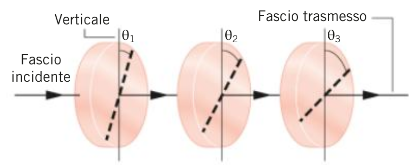Dal secondo polarizzatore emergerà una radiazione, secondo la legge di Malus, data da: e dal terzo polarizzatore emerge la radiazione di irradiamento: Mettendo insieme i due irradiamenti ricaviamo:

|
Poichè il fascio luminoso non è polarizzato dal primo polarizzatore emerge una radiazione di irradiamento I0/2 polarizzata linearmente
con campo parallelo al suo asse di trasmissione. Dal secondo polarizzatore emergerà una radiazione, secondo la legge di Malus, data da: e dal terzo polarizzatore emerge la radiazione di irradiamento: Mettendo insieme i due irradiamenti ricaviamo: |
 |